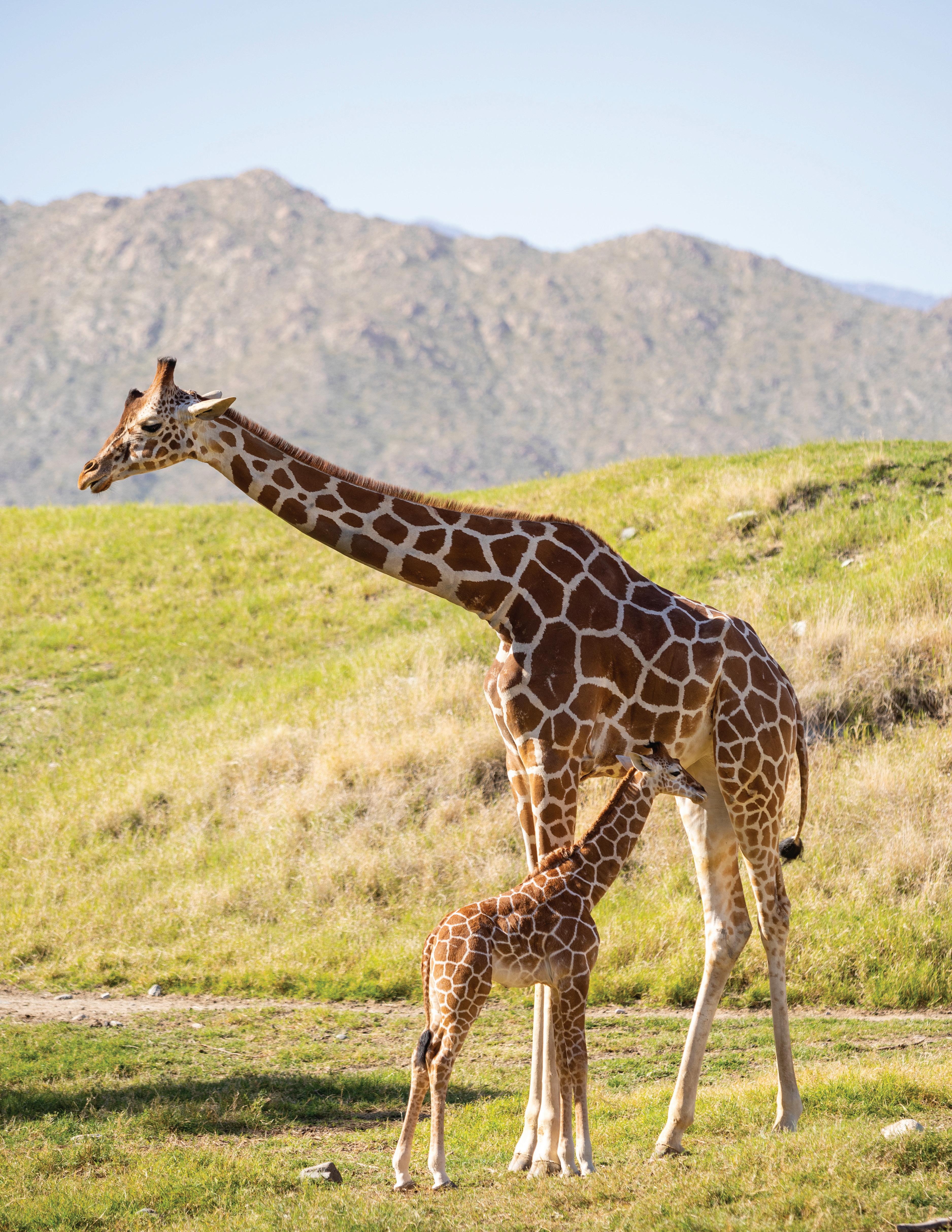






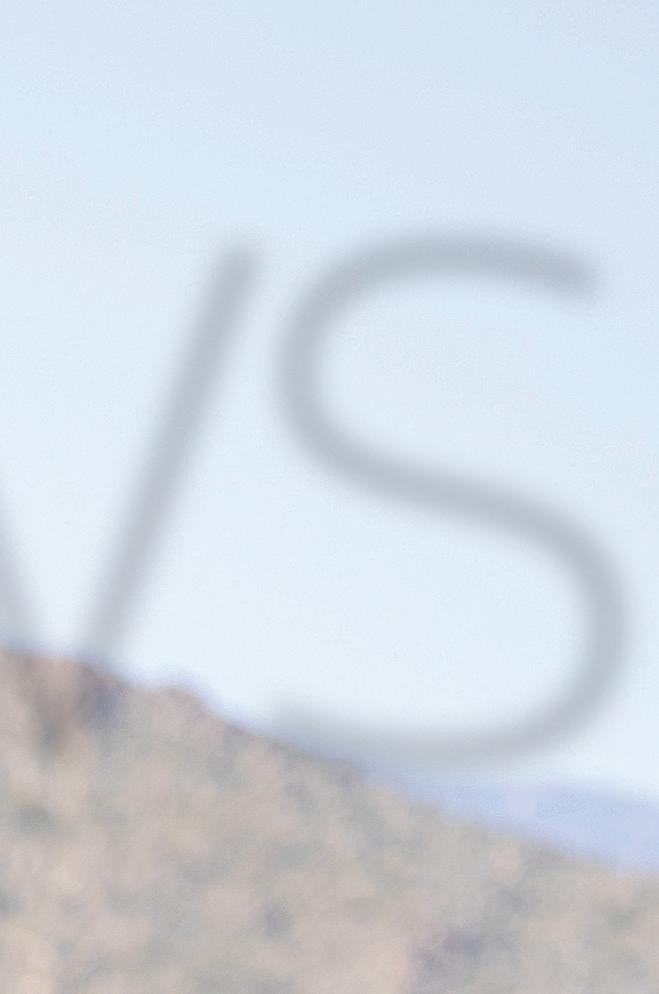
Chairman Bill Appel*
Treasurer Craig McCollam*
Secretary
Sandra Cooper Woodson*
President/CEO
TRUSTEE
LEGAL
Brian S. Harnik Roemer & Harnik, LLP
Deborah Chapman*
Marylynn Gladstein
Jim Gould
Candace Holzgrafe*
H. Earl “Bud” Hoover II
Suz Hunt*
Michael Kiner
Jaishri Mehta
Jneil Nelson
Peter Scheer
Michael Schreter
Sally Simonds
Bill Simpkins
Phillip K. Smith, Jr.*
Mary Lou Solomon
Larry Spicer
Sam Spinello
Nancy L. Stegehuis*
Judy Vossler
*Board of Directors
Coachella Valley Water District Jim Barrett and Anthony Bianco
The Living Desert Zoo and Gardens is a California 501(c)(3) non-profit public benefit corporation which receives no ongoing municipal tax support (EIN 953385354). We are supported solely by the generosity of individuals like you — your ongoing gifts make all that we do achievable. Donations are tax-deductible to the fullest extent possible. For more information, contact Development@LivingDesert.org or 760-346-5694.





THE OTHER DAY, a business colleague asked what I thought the secret sauce was for The Living Desert Zoo and Gardens’ success over the last few years. I told him it was simple — the dedication of the people involved with every facet of our operations. Impactful businesses do not just spontaneously happen; they require talented, devoted people who believe in what they are doing. We are blessed to have just such a group supporting our desert education and conservation mission. Today, I’d like to introduce
you to the incredible team that makes The Living Desert so special.
As is required by law, our nonprofit is overseen by a volunteer Board of Trustees who ensures we are accomplishing our mission and have the financial resources to be successful. Led by Chairman Bill Appel, board members serve as community ambassadors for The Living Desert; sharing what we do, why it is important, and how everyone can help.
Another group who contributes to

our success is the 500+ volunteers that help throughout the Park. Retirees, snowbirds, teens, or the occasional working professional who are looking to put their talents to good work support the Zoo’s mission in many ways. After orientation and training, some volunteers work behind the scenes doing everything from preparing animal diets, working in the plant nursery and greenhouse, or assisting in the preparation for all our special events. The main group, however, assists us in communicating to the guests what is so special about desert habitats and the unique animals that live there. These interpreters fill in the blanks between what guests see during their visit and what they think they know about our diverse animal ambassadors.
The last ingredient in our secret sauce is the more than 200 dedicated employees who strive to make sure the Park operates at the highest level. These professionals make sure that every detail is planned, analyzed, and carried out so that our guests have the “best day ever experience” and the animals under our care are thriving with the highest possible wellbeing.
I am proud of everyone I work with that contributes their energy and passion into making The Living Desert Zoo and Gardens such a spectacular success.

Allen Monroe, President/CEO

The critically endangered black rhinoceros is threatened primarily by habitat loss and poachers in search of rhino horns. The SAFE Black Rhino program is working to raise awareness and build relationships with conservation field partners in Africa. At The Living Desert, Jaali helps to share the story of his species.
Working together in the SAFE program, The Living Desert and other accredited institutions help to save and protect threatened species, both in the wild and in human care.By RoxAnna Breitigan, Chief Operating Officer
SAVING ANIMALS FROM EXTINCTION is a lofty goal, but one
The Living Desert is committed to for desert species. As an accredited organization within the Association of Zoos and Aquariums (AZA), we have the ability to collaborate with over 230 other conservation organizations in 46 states and 13 countries to work together towards that goal. Who is AZA? Their mission is: “The Association of Zoos and Aquariums helps its members and the animals in their care thrive by providing services advancing animal welfare, public engagement, and the conservation of wildlife.” As proud members of AZA, we are leaders in animal care, conservation, and education. Collectively, we envision a world where all people respect, value, and conserve wildlife and wild places.
AZA created the SAFE: Saving Animals From Extinction program in 2015 to harness AZA members’ collective knowledge and reach for the promotion of wildlife protection. By sharing the stories of ambassador animals and global conservation efforts for their wild counterparts with guests, SAFE messaging allows us to leverage our audiences to save species. AZA zoos and aquariums have more visitors annually than the MLB, NFL, NBA, and NHL combined. This is a remarkable opportunity to spread our conservation stories and messages to millions.
The SAFE program creates an avenue for a focused effort with a specific action plan for species. The Living Desert has been supportive of these
efforts since the inception of SAFE, with team members taking on lead roles in some of the programs. The SAFE framework encompasses protecting threatened animals by building on established recovery plans and history of commitment, prioritizing collaboration among members, implementing strategic conservation and stakeholder engagement activities, and measuring and reporting conservation progress.
The Living Desert has proudly been involved with SAFE since the beginning. Vice President of Conservation Dr. James Danoff-Burg is the Program Leader for SAFE Vaquita, spreading the message of one of the most endangered animals in the sea. Vice President of Learning and Impact Dr. Anna Young has brought the SAFE North
The SAFE program helps to protect threatened species, such as giraffe, vaquita, and North American songbird, through increasing public awareness and support of conservation partners in the field.

American Songbird’s messages and activities to the forefront of many of the Zoo’s events. Personally, I have been involved with SAFE Giraffe since it began as part of the Steering Committee, taking on the Public Engagement Coordinator position. In that role, I created the SAFE Giraffe Messaging toolkit that is available to all organizations that provide a home for giraffe. This allows us to have a unified message with our stories, activities, and social media all being consistent — such as utilizing #StandTallForGiraffe on World Giraffe Day.
Most recently I have taken on the role of SAFE Black Rhino Program Leader. The Living Desert is committed to making a difference for black rhino in the wild and in human care. We have created a dynamic, unique, and forwardthinking habitat for Nia and Jaali,
our resident rhinos, and continue to provide them with the best life possible — making a positive difference in their lives. The Living Desert has committed to black rhinos in the wild by supporting programs like the Black Mambas Anti-Poaching Unit and Wild Natures Institute’s Celebrating Africa’s Giants. Together with partner organizations like Lincoln Park Zoo, Minnesota Zoo, and Omaha’s Henry Doorly Zoo and Aquarium, we have created the first three-year action plan for SAFE Black Rhino. This will support the well-respected International Rhino Foundation (IRF), the resourceful International Rhino Keepers Association (IRKA), Save the Rhinos in Namibia, and Eswatini’s Big Game Parks.
The SAFE Black Rhino action plan includes multiple opportunities
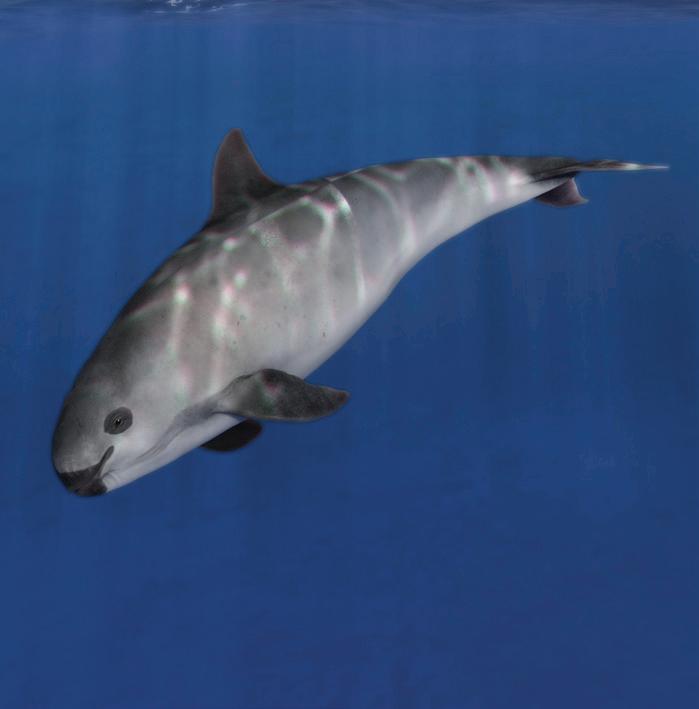

for organizations to get involved. There will be a wish list for each in situ (natural habitat) project that allows anyone to support it in a variety of ways at several different price points. The items on this list range from a pair of boots for a ranger to a translocation of a rhino. IRF and IRKA have an enormous following that will help us spread awareness through sharing stories with their social media followers. The greatest threat to black rhino is the demand for their horn, which we hope to decrease through efforts in this action plan, including education of the public.
SAFE Programs are a wonderful example of how we are stronger and more impactful when working together. This message is one that should resonate with all of us as we continue our hard work to save animals from extinction.

Endangered
SAFE African Painted Dog’s goal is to increase the impact that AZA institutions have on African painted dog conservation in each of its three regions (West and Central Africa, East Africa, and Southern Africa) by increasing conservation support, raising public awareness of African painted dogs in situ and ex situ, and building relationships between AZA institutions and key African painted dog field partners.
Critically Endangered
Through SAFE Black Rhino, the AZA community is helping to reduce demand for rhino horn and raise money to support black rhino habitat conservation, the two greatest threats to this species.
Vulnerable
Through SAFE Cheetah, AZA organizations and partners are supporting projects for public engagement, incidental catch from snares, population sustainability, and animal reserves to help increase cheetah population numbers in southern Africa.

Endangered to Critically Endangered
SAFE Giraffe’s goal is to support giraffe conservation by demonstrating measurable positive impacts of AZA members on the conservation of giraffe, increasing the number of AZA members that support field conservation, ensuring the stability of conservation programming, and engaging the worldwide zoo community and increase overall support.
Least Concern
SAFE North American Monarch’s goal is to take action for monarch conservation [by inspiring] increased action throughout their communities through public education and engagement, and promote reduction of the threats to monarch butterflies with specific conservation outcomes.
Least Concern to Critically Endangered
SAFE North American Songbird’s goal is to reduce the threats to North American songbirds and secure sustainable wild populations of these species

throughout their ranges by harnessing the collective strengths of zoos, aquariums, and partners through supporting education and on-the-ground conservation activities on AZA facilities, in the community, and at state, national, and provincial levels.
Critically Endangered
SAFE Vaquita’s goal is to work with and for the people of the Upper Gulf of California to create sustainable fisheries and communities in support of thriving marine life populations.
Vulnerable
SAFE Western Pond Turtle’s goal is to support the assessment of western pond turtle populations and their threats, engage the public, build public and combined stakeholder efforts, and support works that increase the number of turtles living in natural areas in the species range.
SAFE program descriptions courtesy of AZA.org, visit AZA.org/SAFE-species to learn more.
AT THE LIVING DESERT Zoo and Gardens, the Learning and Impact Department has the goal of making conservation action relevant and achievable for all. Formerly known as the Education Department, a name change to Learning and Impact better reflects the range of people and activities with which we engage. Comprised of Learning and Community Engagement, Sustainability and Behavior Change, and Volunteer and Interpretive Programs, we are on a mission to captivate lifelong learners and ignite a passion for desert conservation. With ZooCamp, The Living Desert has a long history of engaging elementary kids. To expand to other age groups, the team has brought back a program for toddlers, Me & You at the Zoo, and launched a unique new Senior Outreach Program.
ME & YOU AT THE ZOO
Volunteer and Interpretive Programs have taken Me & You at the Zoo to new heights. This program is free with Zoo admission and offers families with early childhood learners a dynamic drop-in session every Tuesday during the season (October through April) from 9:00am-10:00am at the Learning and Impact Department building.
After the program, parents often linger on the patio, exchanging contact details to plan future playdates. It’s a community-building extravaganza that goes beyond the bounds of traditional education. Join the group on a
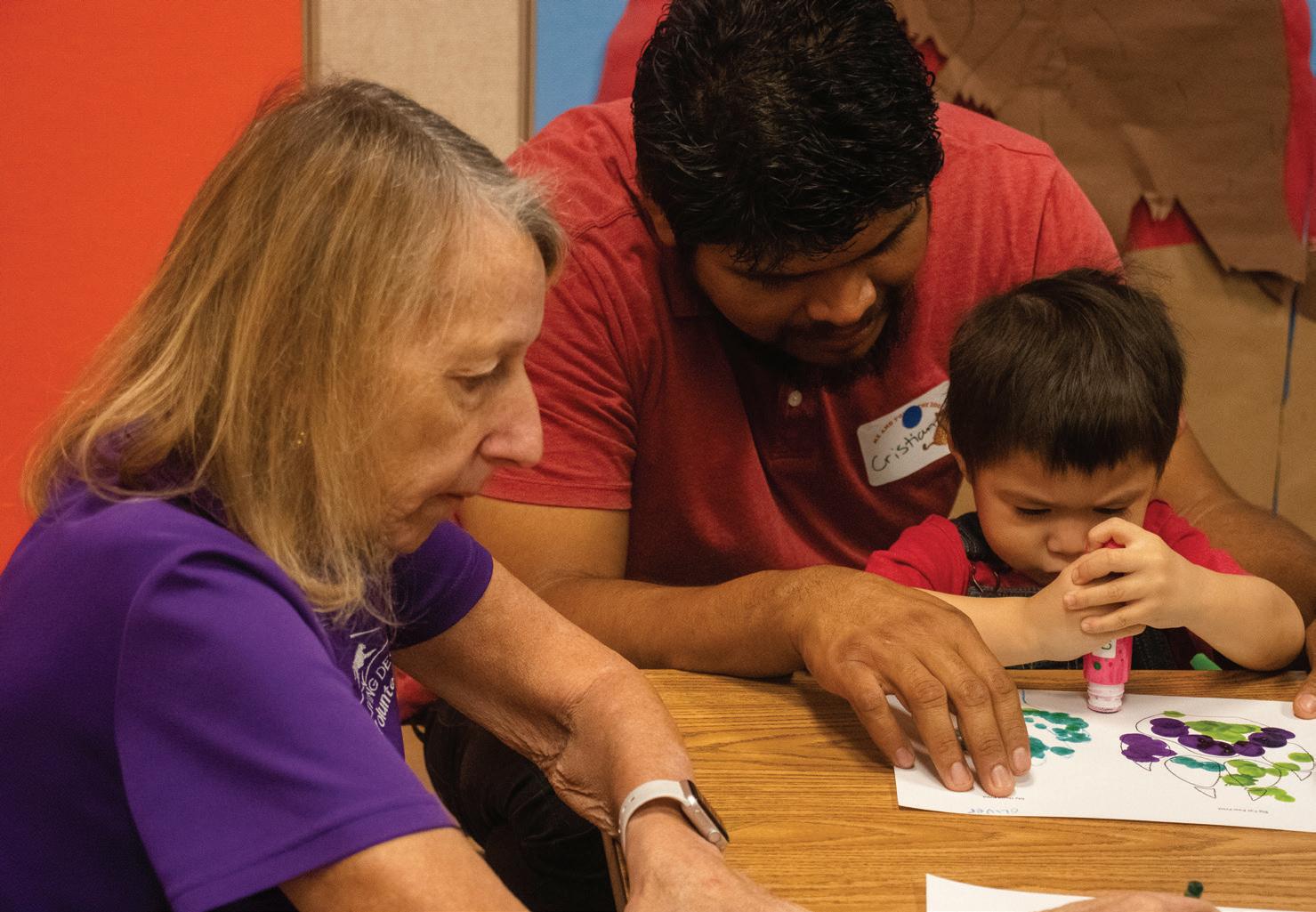
“ Loved bringing my toddler in for us to learn and play together. Thank you for such a lovely experience. We can’t wait to come back.”
— Me & You at the Zoo parent
LEFT: During this weekly program, families dive into an interactive, parent-participation experience led by our passionate volunteers, many of whom are former educators.
RIGHT: Me & You at the Zoo sessions are expertly crafted to be full of hands-on activities, fostering social interaction, collaboration, emotional learning, and excitement about fascinating animal facts.

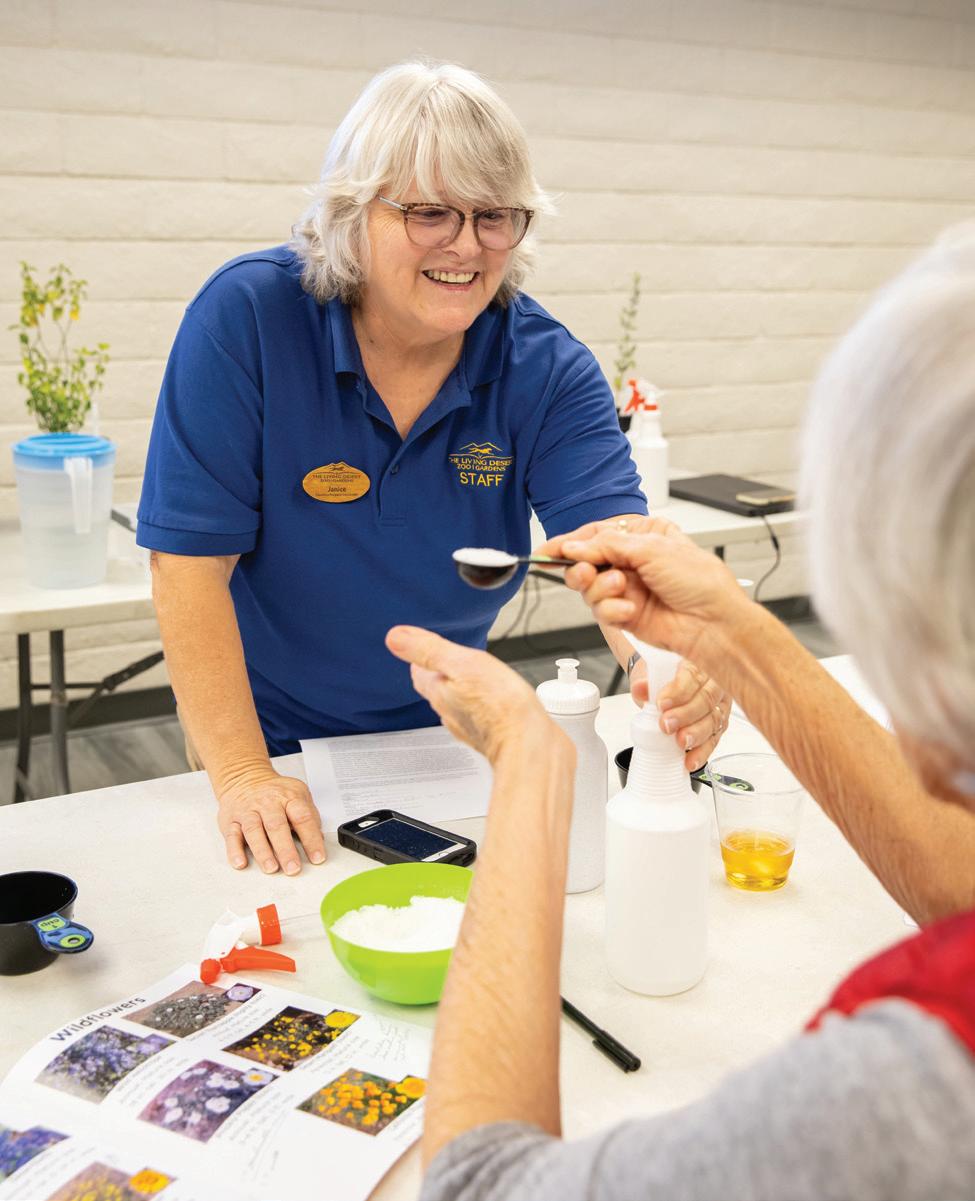
RIGHT: During this outreach program, seniors embrace the importance of native plants. Through hands-on experiences with blooming and seed-bearing plants, they are encouraged to transform their yards into thriving, wildlife-friendly sanctuaries.
Tuesday morning, and you’ll feel the magic as you become part of a vibrant community committed to wildlife, learning, and unforgettable experiences.
The Living Desert’s Senior Outreach program is redefining the meaning of vibrant, engaging, and educational experiences for our cherished seniors. This program is free to residents, thanks to a generous grant from the Auen Foundation. Volunteers play a pivotal role — bringing a dynamic blend of presentations, personal experiences, and a passion for conservation straight to local senior centers, assisted living programs, and memory care facilities.
Each outreach is an enriching journey where seniors not only enjoy socialization and community involvement but also dive into intellectual stimulation. The outreach events spark curiosity with a focus on native flora and
“ I learned just how vital the pollinators are to our survival — and the amazing variety of pollinators there are here in the valley.”
— Senior Outreach program participant

fauna, emphasizing conservation — leading to lively conversations with friends and family.
The ripple effects of this program extend beyond the immediate joys. Residents have begun planting native gardens, creating homemade pollinator-friendly plant spray, and embracing water-saving habits. Other long-term benefits include fostering healthy habitats, safe trail usage, a deeper understanding of local ecosystems, and a commitment to conservation stewardship. Seniors are not just participants; they become desert defenders in their own communities and earn a rewarding sense of purpose.
The Senior Center programs are booming, with attendance soaring at each event. To date, The Living Desert has made 42 visits in total to senior centers, assisted living, and memory care facilities, bringing the programming to 1,067 seniors. The hands-on activities, from crafting coyote hazers (deterrents) to pollinator-friendly concoctions, have become crowd favorites. Interactions are lively; filled with questions, storytelling, and an abundance of enthusiasm. As we wrap up the grant’s first year and prepare for our second year, we’re eager to expand our reach, collaborating with more senior centers and creating even more unforgettable programs in both English and Spanish.
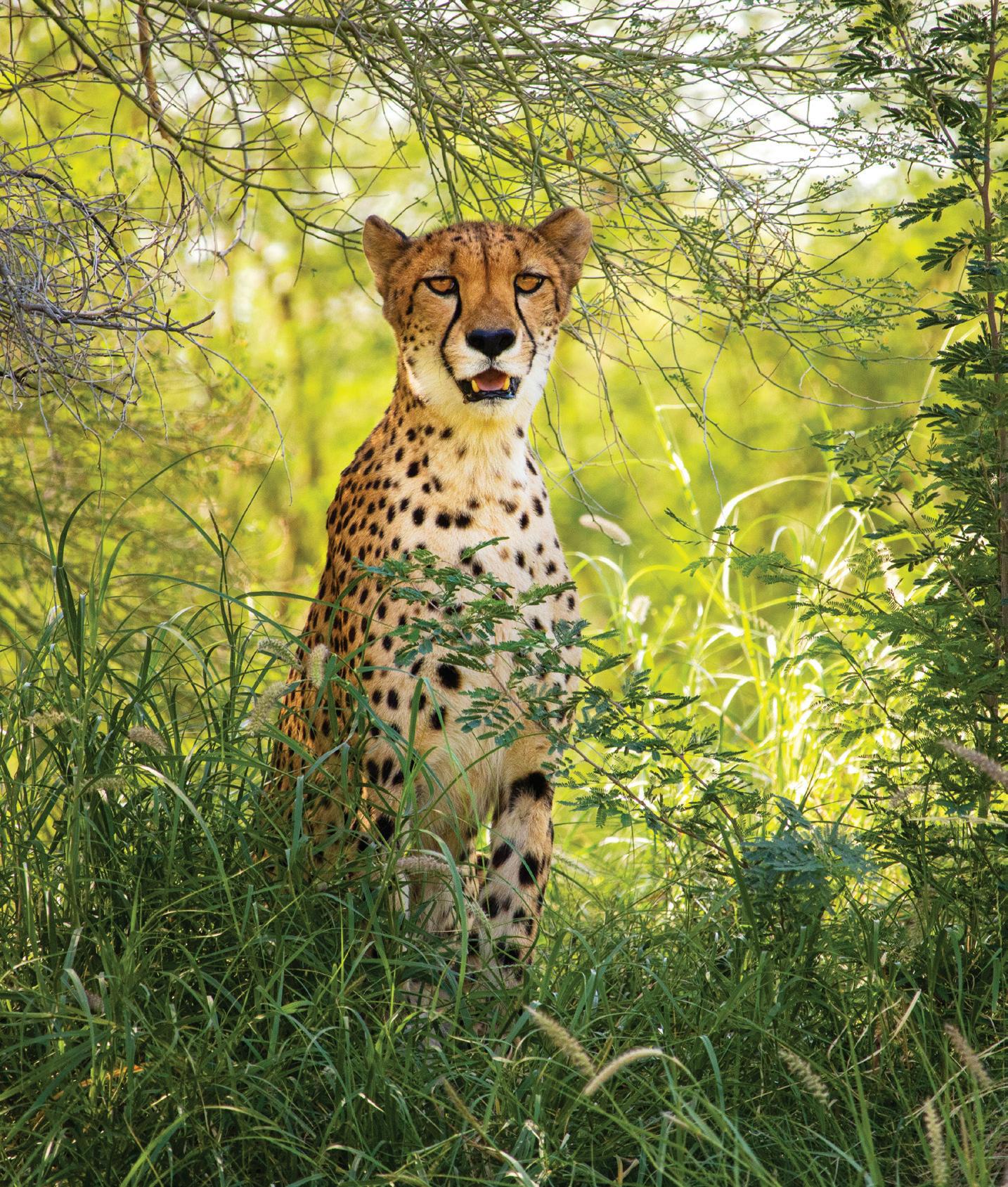
LEFT: The vulnerable cheetah population has fewer than 7,500 mature individuals left in the wild. The Global Cheetah Conservation Summit, held in Ethiopia and organized by Cheetah Conservation Fund, brought together experts from around the world to discuss the urgent need to protect the species.


THE LIVING DESERT is already recognized as a leader in field conservation efforts in Southern California, and that profile continues to expand and improve. In less than a month at the start of this year, The Living Desert launched worldwide celebrations of desert conservation, helped lead an effort to save cheetahs globally, and brought together hundreds of people to honor desert conservation heroes. This year, the Zoo’s already impressive international conservation efforts are poised to be more successful than ever before in working with Indigenous people and local communities to advance animal, plant, and ecosystem conservation.
The first-ever World Desert Day was launched on January 13, 2024. This one-of-a-kind, Zoo-wide event was created by The Living Desert to occur on the second Saturday in January with the goal of celebrating the beauty and diversity of deserts all around the world. The number of like-minded desert celebrants that attended the event more than doubled the number of people normally in the park on this day! Next year, we look forward to rolling it out with all our desert-focused conservation partners around the world. Check out the joy on social media using #WorldDesertDay and spread the good news.
Two weeks later, the Global Cheetah Conservation Summit in Addis Ababa, Ethiopia was held. I was honored to help facilitate this first worldwide planning summit for all people who are involved in cheetah conservation on behalf of the Cheetah Conservation Fund. This global effort involved around 125 people from over 30 countries. Our goal was to begin the process of creating a toolkit of successful interventions across the entire range of the cheetah in Africa and Southern Asia. This toolkit will be summarized and made available for all to use as a starting point when trying to reduce the two main threats to cheetah: human-wildlife conflict and wildlife trafficking. My presentation on the essential need to address the human dimensions of conservation by placing Indigenous People and local communities as leaders of local conservation projects was well received. The situation for the cheetah is dire, but the range of successful solutions that were discussed was really inspiring. I came away from the meeting feeling a strong sense of hope for the future that we can help collectively bring cheetah back from the brink of extinction.

Lastly, we were able to host our first in-person International Desert Conservation Summit (IDCS), a three-day celebration of desert conservation, from February 2-4, 2024. We have had two previous versions of the IDCS that were online-only during COVID-19, so many people were eager to convene in person. The event sold out in only one and a half weeks once we started advertising and could have easily sold out twice or even three times more.
We hosted eight International Desert Conservation Heroes from six countries over the weekend while also highlighting four of The Living Desert’s Conservation Leaders. We kicked off the weekend with an enthusiastically received video night on Friday before the day of the Summit where our Heroes compellingly introduced and then shared their stories visually. During four panel discussions on Saturday, our Heroes and The Living Desert team shared conservation stories and answered questions posed by the attendees and me. Jeff Corwin was our Keynote Speaker and gave an enthusiastic, inspirational, and well-received presentation. Sunday was filled with a day of tours highlighting The Living Desert, our 80+ conservation projects, and our Desert Heroes. Importantly, our entire Zoo staff pitched in and, as with World Desert Day, were amazing in helping to plan, coordinate, and implement the entire event. The Living Desert is making a difference for conservation globally and we are grateful that you are a part of Team Conservation!
Zoya, an amur leopard, is 21 years old — surpassing the median life expectancy of her counterparts in the wild (10-15 years) and in human care (15-20 years). Despite her age and decreasing kidney function, Zoya is very spry and athletic, able to navigate her habitat with ease — often jumping up high for a better vantage point. Learn more about her care and training by scanning the QR code on the next page.

THE ANIMALS WHO CALL The Living Desert home receive care throughout their entire lives, which also includes geriatric and end-of-life care. Each species — no matter how great or small — matters to everyone at the Zoo, and every decision we make on their behalf is meant to keep them safe and protect them from the elements, disease, injury, and even predators. The animal care team works diligently to provide the highest quality of care each day, so every animal has active and dynamic days with as little threat from these challenges as possible. As an animal’s care evolves over the years due to aging and specific needs, the keepers adapt to each animal’s unique situation, which includes caring until the very end of an animal’s life.
Because many of the animals at The Living Desert often outlive their average life expectancy, geriatric
care is a critical part of the care provided at the Zoo. Typically, animals in human care live much longer than their counterparts in the wild. This is not surprising, since The Living Desert’s residents receive excellent medical care, as well as regular and nutritionally balanced meals. The animals also have an entire animal care team keeping watch every day.
Aging animals can experience many of the same ailments that aging humans have, including joint stiffness, arthritis, failing eyesight and hearing, dental issues, muscle-tone loss, or even more serious issues like cancer or kidney failure. On a daily basis, the animal care team uses their excellent observation skills to notice changes in each individual. Animals are equipped to hide many of these ailments to make them less noticeable to predators, so the animal care keepers need to pay particular attention to notice subtle changes.
Here at The Living Desert, we have the privilege of caring for animals who have outlived the median life expectancy. We will create care plans for the older residents to provide them with comfort through their ailments. By utilizing both observational, diagnostic, and therapeutic techniques, the animal care and veterinary teams can continue to provide the highest quality of life for these animals with special needs. This includes knowing when the appropriate time may be to say goodbye. This is one of the most difficult parts of the animal care profession, but when this decision has to be made, it does become the last gift we can give to the animals. We take on the responsibility of alleviating any suffering they may be experiencing towards the end of their life. We take this responsibility seriously and the decision is made respectfully.
The animal care and veterinary teams utilize their own professional experiences to provide whole life care, but will also consult with other experts, including specialists from universities, human medicine, specific veterinary fields, other zoos, and species advisory groups. When we collaborate with others, this can help the species overall as well as the individuals in our care. We are learning and sharing, as an animal care community, to provide better veterinary, husbandry, and wellness care. The Living Desert is committed to each animal until they leave us, and we work hard to help them make life’s transitions with the highest level of care, compassion, and expertise.
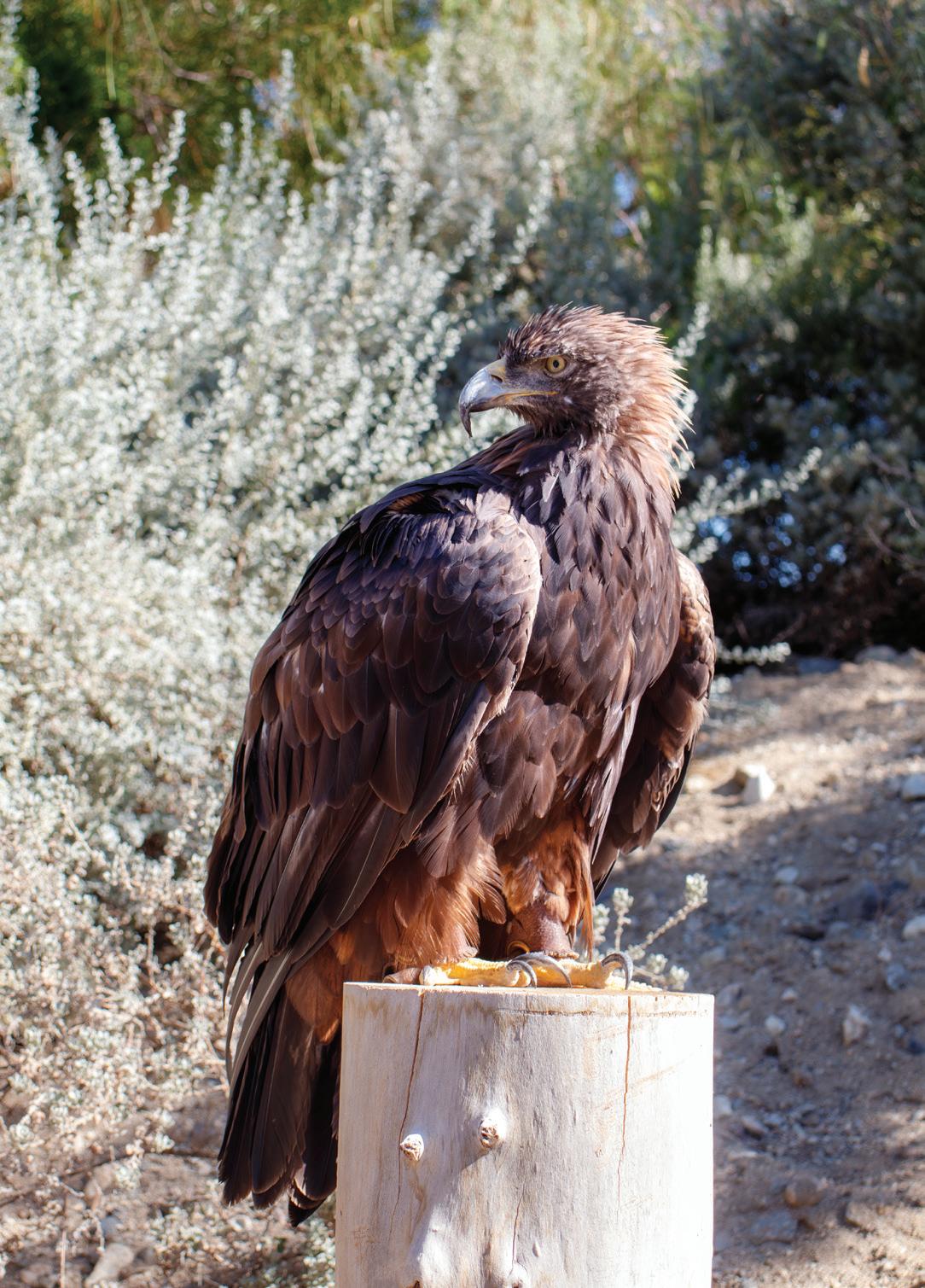
Saying goodbye in death is one of the most difficult parts of the animal care field. Losing an animal that you have a relationship with is never easy. When an animal dies of natural causes, especially for the animals who live past their median life expectancy, it can be a little easier to have the comfort of knowing they had a long, good life. When the decision to compassionately euthanize an animal needs to be made, great effort is taken to make the act as stress free as possible. Keepers will spend extra time training an injection behavior so the final act is calm and peaceful.

and endof-life care and training.
Many guests are familiar with our larger mammals such as black rhino, giraffe, cheetah, and mountain lion; but all the 150+ species at the Zoo have a fascinating ecology. These interesting and sometimes elusive mammals all call The Living Desert home, have you met them yet?

SHORT-BEAKED ECHIDNA
Tachyglossus aculeatus
The fascinating short-beaked echidna is a monotreme, a mammal that lays eggs. The female has a pouch on her stomach where she keeps the small egg that hatches into a young echidna (called a “puggle”). The young echidna then nurses on milk from glands within the pouch. Echidnas have dark fur under barbless spines that are actually specialized hair. These spines are their main line of defense, allowing the echidna to roll up into a sharp ball or dig their way to safety. Interestingly, the echidna has no teeth! Their slender snout and long, sticky tongue helps to catch insects while their strong claws aid in breaking open logs or nests. Native to Australia, Tasmania, Indonesia, and southern New Guinea, the short-beaked echidna can be seen at The Living Desert next to the bettong habitat in Australian Adventures. TIP: The echidna is most visible in one of her many burrows and is often active around 11:00am to 12:00pm.

Nasua narica
This striking species looks similar to its relative, the raccoon, but larger in stature and with an elongated, flexible nose that helps the coati to forage for food. Their long, banded tail aids in balancing as the coati climbs about in trees. White-nosed coati are native to southern Arizona and New Mexico, Central America, and into South America. At the Zoo, coati can be seen in the habitat between the Desert Plant Conservation Center and Eagle Canyon. TIP: Look up to spot the coati climbing in the trees or check their rocky cave/den nestled in the hay, where they like to sleep.
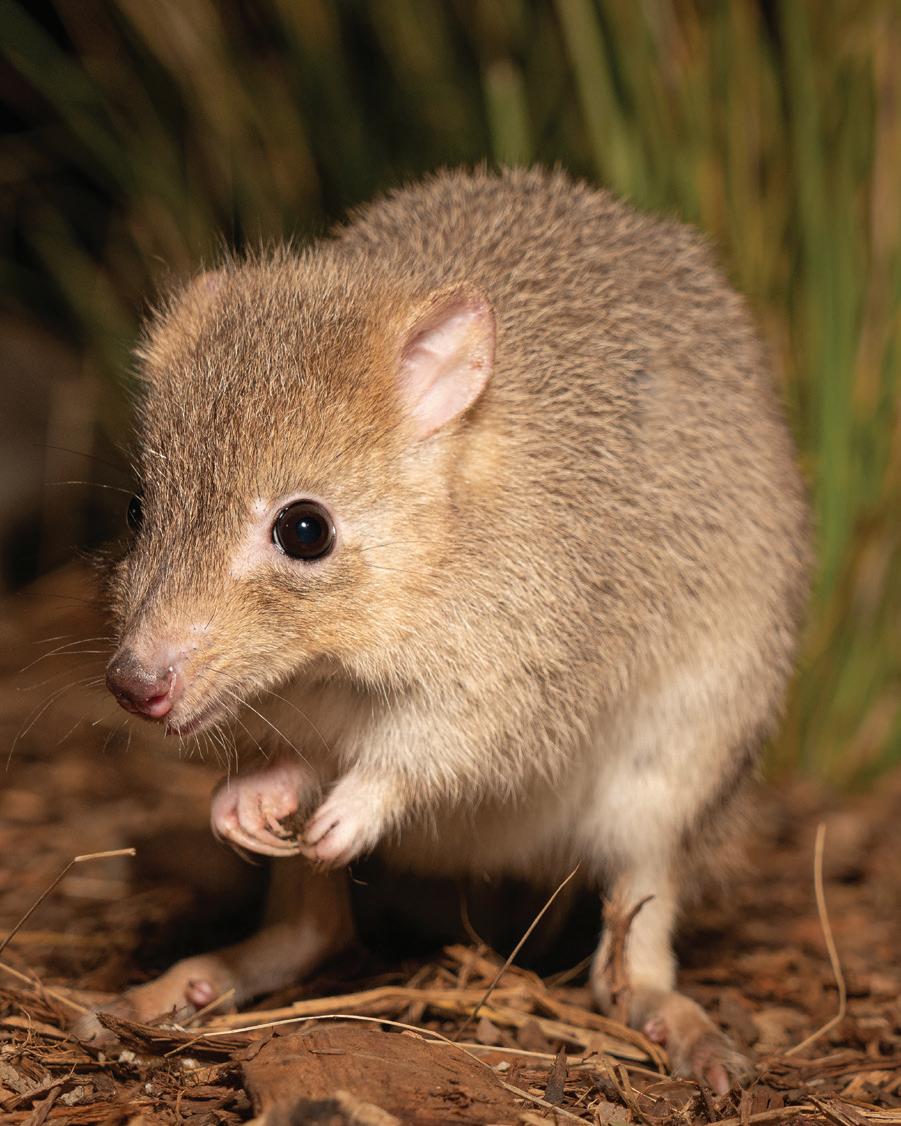
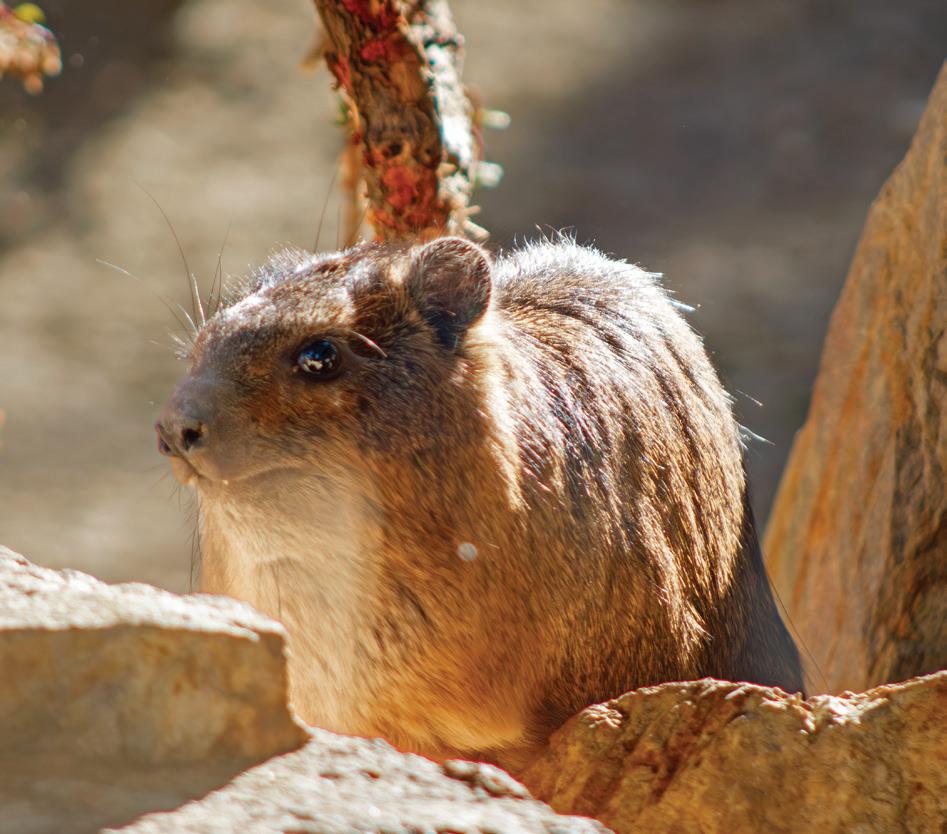
Procavia
At first glance the cape rock hyrax resembles a rodent, however, this species is most closely related to elephants and manatees. Their two upper incisors are reminiscent of tusks and are a unique characteristic. These agile mammals can maneuver uneven ledges thanks to their feet, which act like suction pads. Cape rock hyrax use their surrounding environment to regulate their body temperature and are a social species that reside in larger colonies. These distinctive animals are native to most of Africa and the Arabian Peninsula and can be found at The Living Desert with bat-eared fox and leopard tortoise — all native African species. TIP: Check inside the logs to spot the hyrax!
Bettongia
These small, bipedal marsupials are critically endangered. Also known as “woylies,” brush-tailed bettongs have a prehensile tail that is used for grabbing natural materials like grass and branches to build their nests. Using their front feet to dig and forage also helps the surrounding ecosystem, spreading seeds and turning over topsoil for the nearby plants and wildlife. The brush-tailed bettong does not drink water and has a diet consisting primarily of fungus, bulbs, insects, and seeds. Native to Australia, this species can be seen at the Australian Adventures habitat. TIP: Bettongs are nocturnal and often spend the day resting in their grass nest. Ask an Australian Adventures animal keeper to point them out!
TO BECOME A MONTHLY DONOR, PLEASE VISIT:

*AMOUNT BASED ON PROJECTED BUDGETARY EXPENSES FOR 2025.
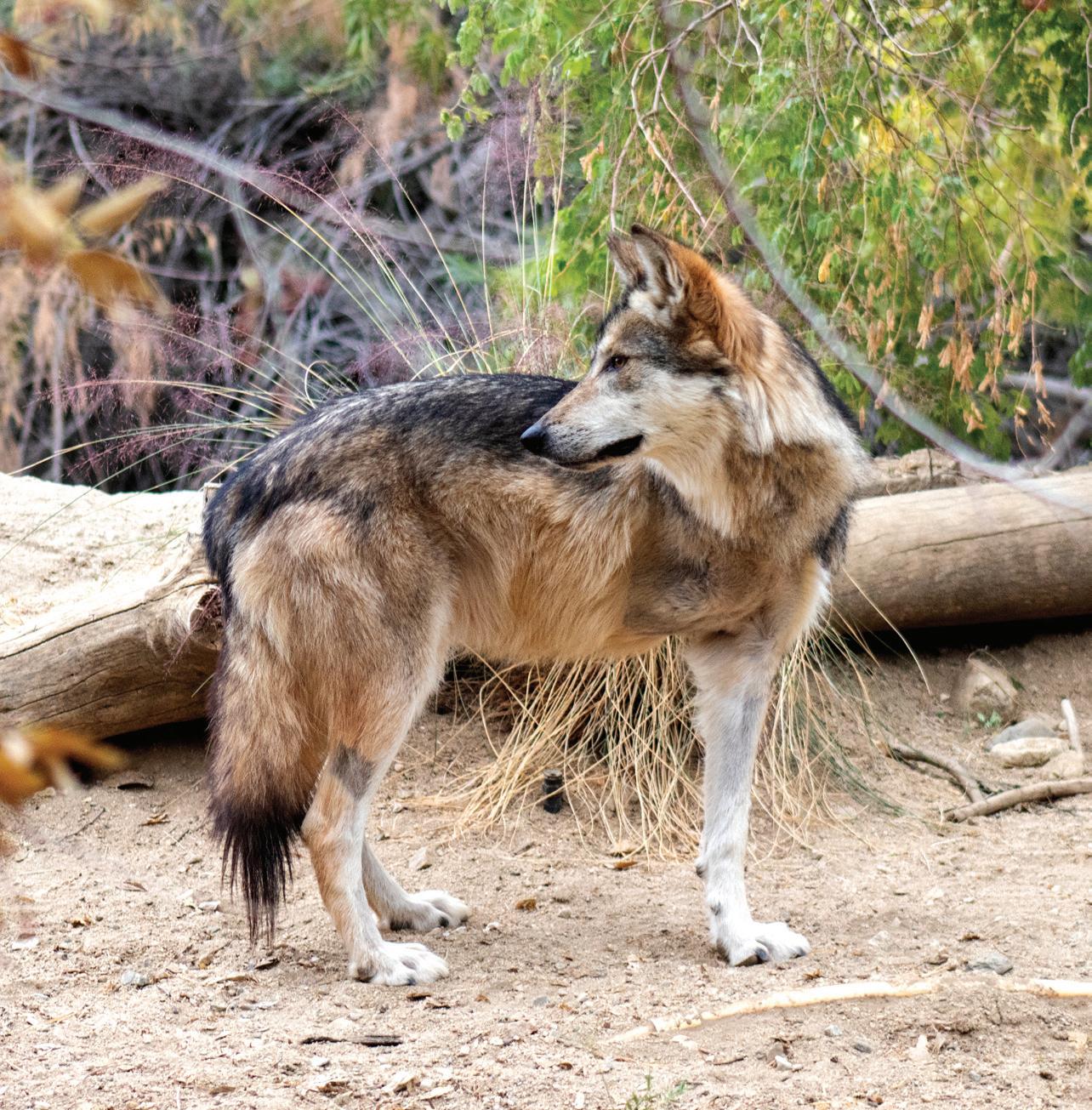
In the fall of 2023, Mexican wolf Soleil Ellen injured her front leg after landing awkwardly from a jump. Following a thorough examination by The Living Desert’s veterinary staff and consultation with multiple experts in the field, it was decided that amputation was the best and most humane course of action for Soleil Ellen. Wolves are incredibly resilient, and she healed quickly after the surgery.
Soleil Ellen was introduced back to her habitat only two weeks after the injury and has been thriving ever since, alongside packmates Drew Hudson and Paul Newman! With remarkable strength and resilience, Soleil Ellen swiftly adapted to having three legs — even running as fast as her four-legged packmates. “Animal care staff have witnessed Soleil regain her
strength, run, cool in the pool, participate in pack behaviors such as patrolling with the boys, exploring habitat space, and sharing meals among her wolf peers,” said Animal Care Lead Keeper Claudia Garcia, one of the team members who care for Soleil Ellen. The Zoo’s animal care and veterinary teams continue to monitor Soleil Ellen’s health and wellbeing.
25 years ago, the Mexican wolf teetered on the brink of extinction. Currently, at least 257 Mexican wolves are living in their native habitats across Arizona and New Mexico, all of which are the result of breeding efforts in zoos, including The Living Desert. Additionally, approximately 350 Mexican wolves receive attentive care from 60 zoos and facilities throughout the United States and Mexico, through the Mexican Wolf Species Survival Plan® (SSP).
In their habitat at Eagle Canyon, Soleil Ellen, Drew Hudson, and Paul Newman continue to share the story of the Mexican wolf. This incredible success story is a reminder that, by working together, we can help endangered species come back from near extinction.
Learn more about Soleil Ellen’s journey toward healing by scanning the QR code.
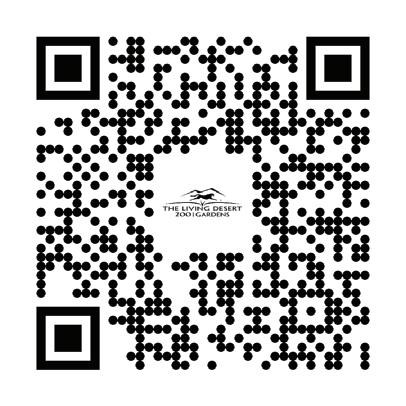
Two healthy meerkat pups were born on January 21, 2024, to Vinny (mom) and Frenzy (dad). The siblings started popping up from their underground den in mid-February, and guests were able to catch glimpses of them playing in the meerkat habitat. This is the second litter for Vinny and Frenzy, who welcomed their first pup in 2022. One of the pups was named Murray by longtime supporters Jason and Rob Ollander-Krane.

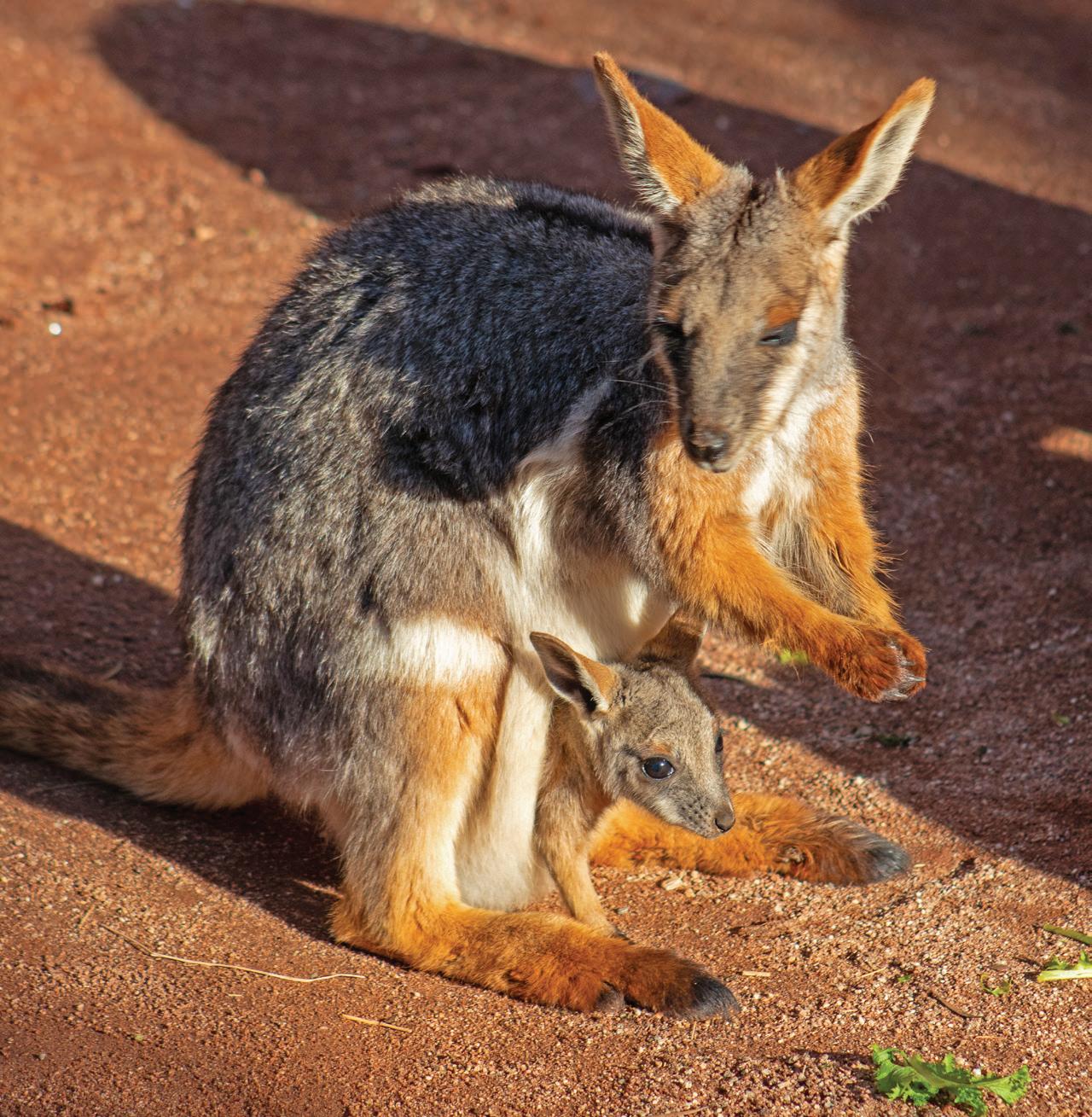
Estimated to be born in September/ October 2023, a yellow-footed rock wallaby joey began popping out of mom’s pouch in mid-February. The young female can be seen in the Australian Adventures habitat with her mom, Aja. The joey was named William, aka Billy, after a friend and supporter of the Zoo, William Rodriguez, owner and CEO of Silvercrest Advertising in Palm Springs. The Living Desert is one of only four U.S. zoos to house this species and is currently the only U.S. zoo to have a breeding mob! Yellow-footed rock wallabies face numerous threats in their natural environment due to climate change, leading to a decline in their population. To help preserve this species, The Living Desert works in collaboration with the Australian Department of Agriculture, Water, and the Environment to house and breed yellow-footed rock wallabies.

A healthy, female giraffe calf was born on January 29, 2024, at the Zoo to first time mom, Vicky Lou, and dad, Kelley. The young calf was named JoAnn in honor of the late JoAnn McGrath, a Living Desert donor and local philanthropist. JoAnn was thriving behind-thescenes with mom and then introduced to the savanna habitat in mid-February, alongside mom and herd mates Tuli and Twiga.
On February 26, 2024, a male giraffe calf was born to mom Shellie. Lovingly named Daniel, in honor of longtime supporter Brooke Koehler’s beloved husband, the young calf is thriving and was introduced to the savanna habitat in early March. At the well-baby exam, Daniel weighed in at 160 pounds with a height of 6 feet 1 inch. In their natural habitat, giraffe suffer from a ‘silent extinction’ that has resulted in roughly 100,000 individuals left today. With the addition of the male and female calves, The Living Desert is now home to 12 giraffe, each helping to share the story of this vulnerable species.
The Living Desert is dedicated to the desert species of the world. These hearty animals and plants are built for extremes in weather and harsh elements. Some animals have body adaptations to help them thrive in high temperatures. The large ears of African painted dogs help to dispel the heat while the light-colored coats of Arabian oryx and addax reflect the rays of the sun. Other animals have behaviors for the warm climate, such as the black rhinoceros that wallow in the cool mud or rattlesnakes that slither to a shady spot. While the species at The Living Desert can thrive in the Coachella Valley temperatures on their own, the animal care team still likes to offer them other enriching experiences to cool off. Many of these experiences are similar to what humans enjoy on a hot summer day — from extra misting systems and pool areas to ice treats and swamp coolers/evaporative cooling options. You may see some of these experiences at the Zoo this summer!
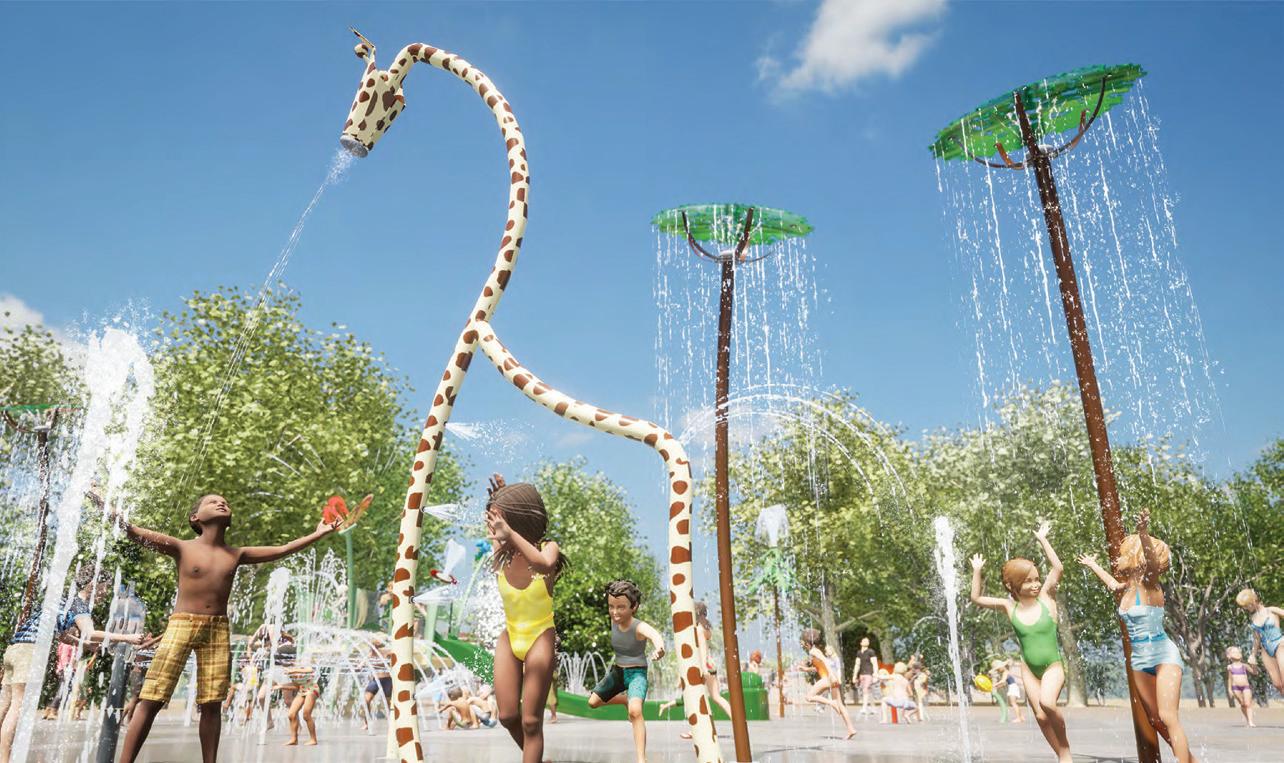
Looking for a cool spot to unwind? Sonoran Pond is the perfect place to take a breather as you relax in a rocking chair under the shaded structure. The calming pond was built when The Living Desert opened in 1970 and is home to a thriving population of the rare desert pupfish. The Living Desert is working to not only maintain multiple, distinct populations of desert pupfish on grounds through refugia, such as Sonoran Pond, but also works extensively near the Salton Sea to restore critical habitat of dwindling wild populations.
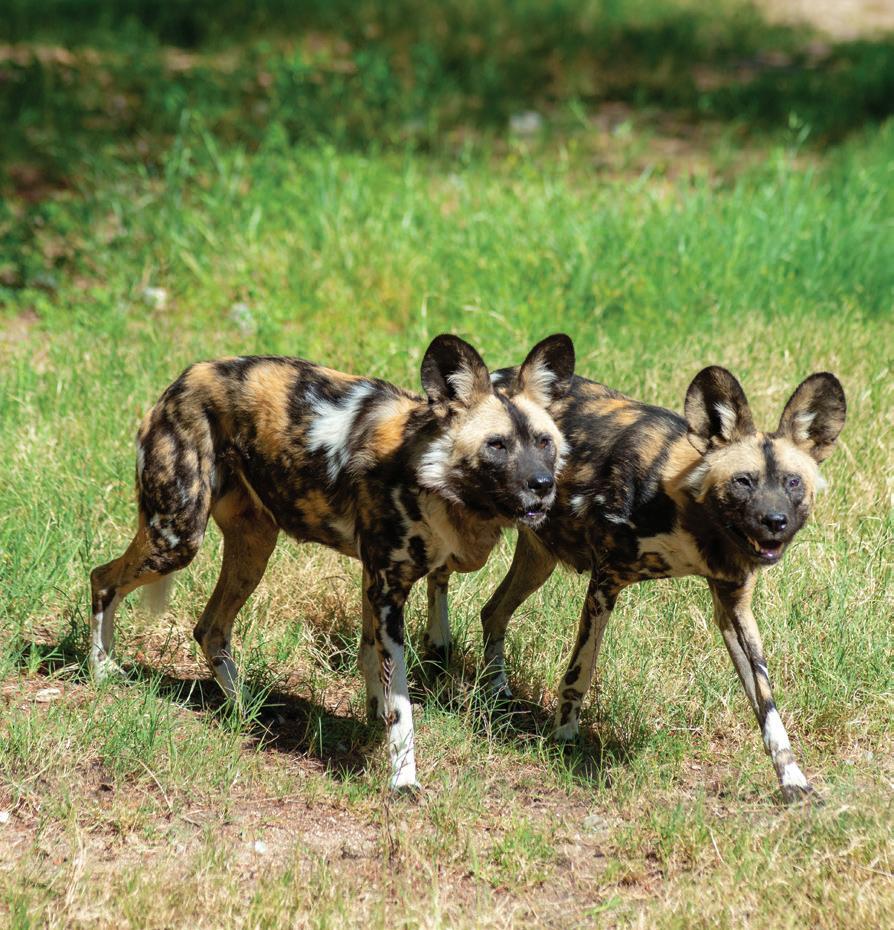
Coming in the spring of 2025, the Zoo’s new splash pad is sure to be a cool addition! This eco-friendly splash pad includes a recirculating system that captures, cleans, filters, and reuses the water — thus the only anticipated water loss will be from evaporation and user water loss. Furthermore, the splash pad was designed with low-flow water features and ondemand activation. Also coming in the spring of 2025, is a new café/marketplace overlooking Bighorn Mountain! Visit LivingDesert.org/SplashPad to learn more.

Newly added to the summer menu at Kookaburra Cafe and Thorn Tree Grill, Cowboy Caviar is a delicious, vegan appetizer that you can also make at home. Cowboy Caviar is packed with nutrients and fiber – perfect for a pre-prepared cold snack or meal.
• 1 can black beans (drained and rinsed)
• 1 can black-eyed peas (drained and rinsed), substitute chickpeas if preferred
• 1 whole tomato (seeded and diced
• 1 large jalapeño (seeded and diced)
• 1 cup corn nibbles (fresh off the cob is best; substitute thawed frozen or canned)
• 1 ripe avocado (chopped)
• 1 large red bell pepper (seeded and diced)
• 1 medium sized red onion (finely diced)
• 1 bunch of cilantro (chopped)
• 1/3 cup olive oil
• 1/4 cup fresh squeezed lemon juice
• 1 Tbsp honey or agave nectar
• 1 tsp chili powder
• 1 tsp cumin
• Salt and pepper to taste
1. Place drained and rinsed beans, and all the chopped ingredients in large bowl.
2. In a separate bowl, whisk together olive oil, lime juice, honey, chili powder, cumin, salt, and pepper.
3. Pour the dressing over the chopped ingredients and toss gently to coat.
4. Serve the dip chilled with your favorite chips.
NOTES FROM THE ZOO’S CHEF TIM WEAFER
• Make ahead instructions: Assemble according to instructions, except omit the avocados. Refrigerate until you plan to serve. Add the avocados right before serving.
• Roma tomatoes work best for this dish, as they have less seeds and a firmer texture. Cherry tomatoes are a great substitute.
• Reserve your canned bean water. It is called ‘aquafaba’ and can be a great substitute for eggs when making vegan mayonnaise or mousse.
Eating vegan helps the planet! Opting for plant-based choices reduces the need for agricultural land, curbing the carbon footprint tied to animal agriculture.
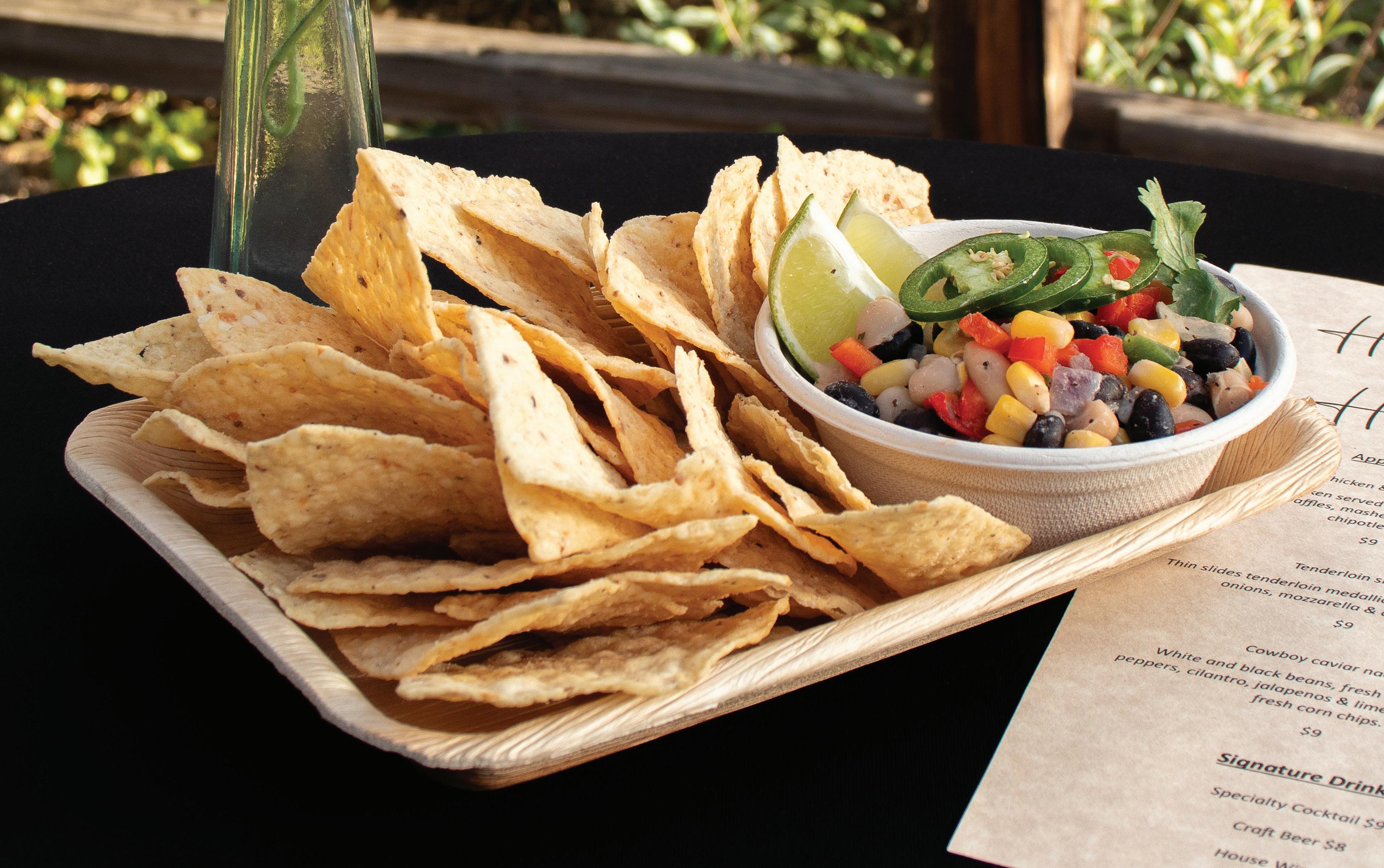
Summer Hours
June 1
From June 1 through September 30, The Living Desert will be open from 7:00am-1:30pm daily, with the last admission at 12:30pm. During summer hours, the carousel and hiking trails will be closed until October 1.
Registration is now open for Summer ZooCamp and Zookeeper Academy! ZooCampers from grades K-9 will learn about wildlife through STEM activities, arts and crafts, up-close animal encounters, and more.
Visit LivingDesert.org/ZooCamp to learn more.
8:00am-12:00pm
June 12-14, 18-20, and 25-27
Themes:
K-1: Destination Imagination
2-3: Junior Vets
4-6: Eco-Engineers
July ZooCamp Sessions
8:00am-12:00pm
July 9-11, 16-18, 23-25, and July 30-August 1
Themes:
K-1: Critter Crafters
2-3: Animal Tales
4-6: Eco-Expression
Zookeeper Academy
July 1-3, 8:00am-12:00pm
Zookeeper Academy has returned this summer, exclusively for seventh-to ninthgraders! This career-based camp will offer a thorough exploration of zookeeping roles. Through engaging activities, campers will delve into animal nutrition, behavior, habitat design, and conservation management, gaining valuable insight into the field. Visit LivingDesert.org/ZooCamp to learn more.
Visit LivingDesert.org/ Events for details about upcoming events!
July 27, 1:00pm-2:30pm
Volunteers at The Living Desert are integral to the Zoo, helping to share our mission of desert conservation with guests each day. Join the wonderfully wild team! Visit LivingDesert.org/Volunteer to learn more.
Applications open September 15 through October 31
Students ages 14-18 are invited to apply to our ZooTeen Program. ZooTeens have the opportunity to gain valuable life and job readiness skills while volunteering in a fun and collaborative environment. Visit LivingDesert.org/ZooTeens to learn more.
August 10
To celebrate the teachers who make up our communities, we’re inviting you to join us for a Teacher Open House at the Zoo. Advance registration is required, visit LivingDesert.org/TeacherDay.
October 1
The Living Desert returns to its regular hours of 8:00am-5:00pm daily, with last admission at 4:00pm. At this time, the hiking trails and carousel will also return to regular hours.
Visit LivingDesert.org/Travel to learn more.
Botswana
October 31 – November 12, 2024
Zimbabwe and Zambia
May 20 – June 1, 2025
Ecuador and the Galapagos Islands
July 24 – August 4, 2025
Help the meerkat pups find their way through the underground den to find mom (Vinny).

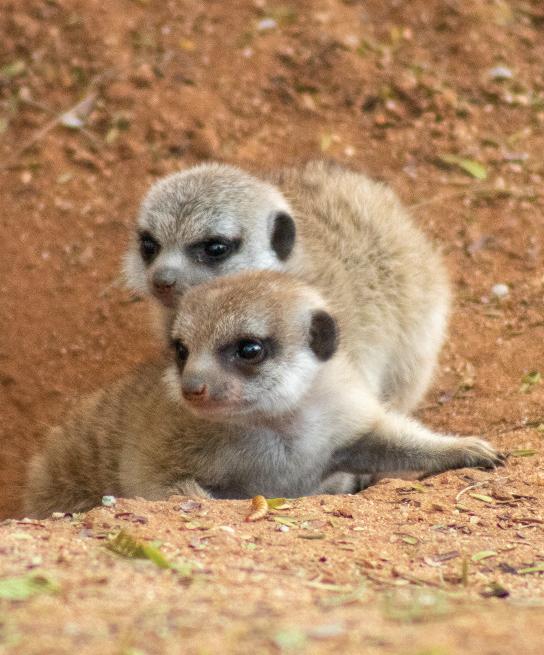












• Meerkats are a member of the mongoose family.
• These furry mammals weigh 1.4 to 2.1 pounds.
• Walt Disney animation artists studied and sketched The Living Desert’s meerkats for the 1994 animated feature, The Lion King
• Turn to page 18 to learn about Vinny (mom), Frenzy (dad), and their two new meerkat pups!
47900 Portola Ave.
Palm Desert, CA 92260





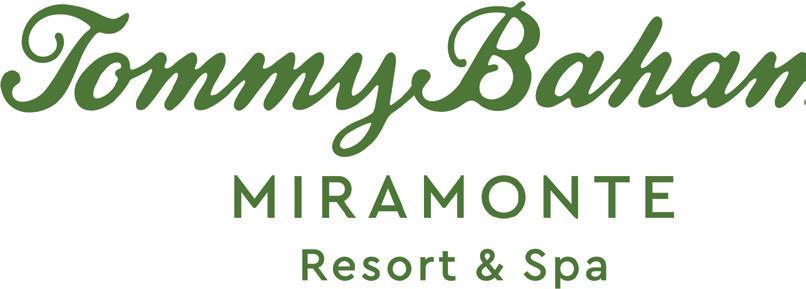

The Living Desert is excited to announce the addition of the Membership Benefits Program. These benefits and discounts are designed to enhance your experience once you leave the Zoo and include many local businesses throughout the area! With your membership, you’ll receive exclusive discounts to places like Tommy Bahama Miramonte Resort & Spa™, BMW Performance Driving School, Palm Desert Grocery Outlet, Luchador Brewing Company, Orangetheory Fitness®, Indian Wells Golf Resort, PS Air Bar, and so much more! And of course, you’ll still receive existing benefits such as foxpaws and free or reduced admission to more than 150 AZA-accredited partner zoos and aquariums.
Visit LivingDesert.org/Membership to learn more.